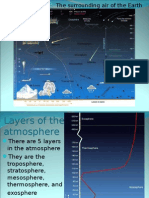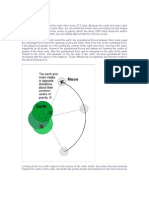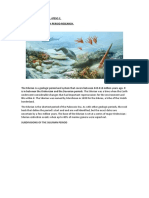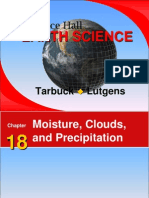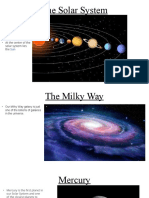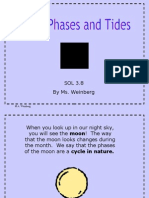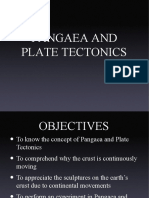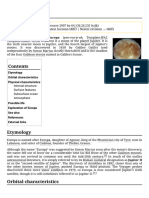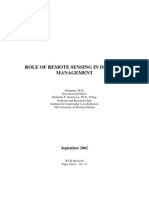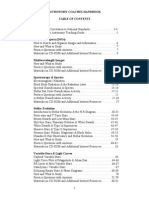0 ratings0% found this document useful (0 votes)
262 viewsTides
Tides
Uploaded by
pisces_sanjeev- Tides are caused by the gravitational pull of the Moon, which creates two bulges in the Earth's oceans - one facing the Moon and one facing away. As the Earth rotates, different locations move between these bulges, experiencing two high tides and two low tides each day approximately six hours apart.
- Spring tides occur during full moons and new moons, when the bulges are largest due to the combined gravitational pulls of the Moon and Sun. Neap tides occur during half moons, when the Moon and Sun's pulls are at right angles and partially cancel each other out, creating smaller bulges.
- The bulge theory explains the basic causes and patterns of tides in a
Copyright:
© All Rights Reserved
Available Formats
Download as PDF, TXT or read online from Scribd
Tides
Tides
Uploaded by
pisces_sanjeev0 ratings0% found this document useful (0 votes)
262 views16 pages- Tides are caused by the gravitational pull of the Moon, which creates two bulges in the Earth's oceans - one facing the Moon and one facing away. As the Earth rotates, different locations move between these bulges, experiencing two high tides and two low tides each day approximately six hours apart.
- Spring tides occur during full moons and new moons, when the bulges are largest due to the combined gravitational pulls of the Moon and Sun. Neap tides occur during half moons, when the Moon and Sun's pulls are at right angles and partially cancel each other out, creating smaller bulges.
- The bulge theory explains the basic causes and patterns of tides in a
Original Description:
how tides happen
Copyright
© © All Rights Reserved
Available Formats
PDF, TXT or read online from Scribd
Share this document
Did you find this document useful?
Is this content inappropriate?
- Tides are caused by the gravitational pull of the Moon, which creates two bulges in the Earth's oceans - one facing the Moon and one facing away. As the Earth rotates, different locations move between these bulges, experiencing two high tides and two low tides each day approximately six hours apart.
- Spring tides occur during full moons and new moons, when the bulges are largest due to the combined gravitational pulls of the Moon and Sun. Neap tides occur during half moons, when the Moon and Sun's pulls are at right angles and partially cancel each other out, creating smaller bulges.
- The bulge theory explains the basic causes and patterns of tides in a
Copyright:
© All Rights Reserved
Available Formats
Download as PDF, TXT or read online from Scribd
Download as pdf or txt
0 ratings0% found this document useful (0 votes)
262 views16 pagesTides
Tides
Uploaded by
pisces_sanjeev- Tides are caused by the gravitational pull of the Moon, which creates two bulges in the Earth's oceans - one facing the Moon and one facing away. As the Earth rotates, different locations move between these bulges, experiencing two high tides and two low tides each day approximately six hours apart.
- Spring tides occur during full moons and new moons, when the bulges are largest due to the combined gravitational pulls of the Moon and Sun. Neap tides occur during half moons, when the Moon and Sun's pulls are at right angles and partially cancel each other out, creating smaller bulges.
- The bulge theory explains the basic causes and patterns of tides in a
Copyright:
© All Rights Reserved
Available Formats
Download as PDF, TXT or read online from Scribd
Download as pdf or txt
You are on page 1of 16
At a glance
Powered by AI
The key takeaways are that tides are caused primarily by the gravitational pull of the Moon, and tide charts can be used to predict high and low tides. Spring tides have the largest tidal range and occur during full moons and new moons, while neap tides have a smaller tidal range and occur during half moons.
Tides are caused primarily by the gravitational pull of the Moon. The Moon's gravity causes the oceans to bulge out in the direction facing the Moon and on the opposite side of the Earth, resulting in high tides in those areas.
Tide charts show the predicted heights of high and low tides over time. High points on the chart indicate high tides while low points indicate low tides. The charts also show the tidal range, or difference in height between successive high and low tides.
Oceanography 10, T.
James Noyes, El Camino College 7A - 1
Oceanography 10, T. James Noyes, El Camino College 7A - 1
Tides
TIDE BASICS
What are tides?
Tides are the slow, daily rise and fall of the ocean surface over a large area caused (primarily) by
the gravitational pull of the Moon. In most places, there are 2 high tides and 2 low tides each
day (24 hours), so it takes about 6 hours for the ocean to go from high tide to low tide.
High Tide Low Tide
High Tide (right) and Low Tide (left). Courtesy of Samuel Wantman (CC BY-SA 3.0).
Tidal Range
High Tide Low Tide
Oceanography 10, T. James Noyes, El Camino College 7A - 2
Oceanography 10, T. James Noyes, El Camino College 7A - 2
Reading Tide Charts
Tides are typically described using tide charts. Reading tide charts is fairly straightforward.
The high points (peaks, crests) in the curve indicate high tides, and low points (valleys, troughs)
indicate low tides. The chart below shows high tides at 3 a.m. and 3 p.m., and low tides at 9 a.m.
and 9 p.m. Sea level rises to 5 feet during the 1
st
high tide, and 7 feet during the second. It drops
to 1 foot during the 1
st
low tide, and 2.5 feet during the second. Sea level measurements are
typically made relative to mean low low water (MLLW), the average of the lowest daily low
tides over a long period of time. Thus, a high tide with a height of 4 feet is 4 feet above the
typical lowest-low-tide-of-the-day.
The difference in height between
successive high and low tides is
called the called the tidal range.
In the chart shown on the right,
the largest tidal range in 6 feet,
the difference in height between
the 1
st
low tide (1 foot) and
the 2
nd
high tide (7 feet).
(Tidal range = 7 feet 1 foot = 6 feet.)
Observations of the Tides
The tide chart below and on the next page shows the tides over a few days. Some interesting
features stand out. Typically there are 2 high tides each day, but there are some days with only 1
high tide and/or 1 low tide
1
(e.g., April 14
th
on the next page). (In some places, this is normal!)
Along our coast, the time between high and low tide can vary from about 4 hours to nearly 8
hours. On average, it takes about 6 hours and 10 minutes to go from high tide to low tide (and
vice versa), so on most days it takes a little over 24 hours to complete the cycle. This means
(and the chart shows) that tides typically get a little later each day. Some days, a tide may only
be 20 minutes later than the previous day, on other days a tide may be 2 hours later than the
previous day. On average, tides are close to an hour later each day (about 50 minutes, to be a bit
more precise).
1
Sometimes this is related to the fact that high and low tides are at little more than 6 hours apart on average.
In other cases it is related to the competing pulls of the Moon and Sun on the ocean (they effectively cancel
one another out).
2
4
6
8
f
e
e
t
Midnight Noon 4 8 4 8
pm
Midnight
am am pm
High Tide
Low Tide
Low Tide
High Tide
Oceanography 10, T. James Noyes, El Camino College 7A - 3
Oceanography 10, T. James Noyes, El Camino College 7A - 3
Notice the link between tides and the phase of the Moon in the tide chart below showing an
entire month of tides. High tides are highest and low tides are lowest during the full moon and
the new moon, whereas high tides are not very high and low tides are not very low during a half
moon. We call the large tidal range (difference between high and low tides) during full moon
and new moon spring tides, and the small tidal range (very little difference between high and
low tides) during half moons neap tides. It takes about a week for the phase of the Moon to
change, so tides switch from spring tides to neap tides in about a week.
New
Moon
Half
Moon
Full
Moon
Phases of the Moon during an entire month.
(Public Domain)
Oceanography 10, T. James Noyes, El Camino College 7A - 4
Oceanography 10, T. James Noyes, El Camino College 7A - 4
Note that spring tides do not happen during the spring. Think of spring tides as springing up
or jumping high. Of course, to jump high, you have to bend your knees (you have to go down
low) first. (Just try jumping without bending your legs: youll look pretty funny.) In the same
way, spring tides have to go down very low before they can jump up high. Think of neap tides
as not very high and not very low; associate the N in neap with the idea that tides are not
extreme during neap tides, that there is not much change.
Do you know why the Moon has phases? Do you know why the face of the Moon changes over
a m onth? The Moon orbits the Earth once per month; in other words, it takes a month for the
Moon to travel all the way around the Earth. (Just look at our word month: it includes the
word Moon! Perhaps we should call it a Moonth insteadjust remember, you heard it here
first.) The Moon shines at night because the Moon reflects the light of the Sun (the light bounces
off of the Moon towards the Earth). Of course, only the part of the Moon facing the Sun receives
light; the part facing away from the Sun is dark. As the Moon orbits the Earth, sometimes we
see more of the bright side, the part facing the Sun, and sometimes with see more of the dark
side, the side facing away from the Sun. Full moon is when we only see the bright side of the
Moon, and new moon is when we only see the dark side of the Moon. Half moon is when we see
equal amounts of the bright side and the dark side. As the picture below shows, full moon (#1) is
when the Moon and Sun are on opposite sides of the Earth, so we see the bright side of the
Moon. The Moon reaches the half moon position (#2) in about a week later as it travels around
the Earth. (At this point, it is of the way around. A quarter of a month is approximately a
week.) In about another week, the Moon and Sun are on the same side of the Earth at new moon
(#3): we can only see the dark side of the Moon.
#1
#2
#3
#4
E S
Spring Tides Full Moon
E S
Neap Tides Half Moon
E S
Neap
Tides
Half Moon
E S
Spring Tides New Moon
Oceanography 10, T. James Noyes, El Camino College 7A - 5
Oceanography 10, T. James Noyes, El Camino College 7A - 5
EXPLAINING THE TIDES:
THE BULGE THEORY OF THE TIDES
The Bulge Theory of the Tides is the Simplest, But Not the Best, Theory of the Tides
There are several theories of the tides. The bulge theory of the tides is better known as the
equilibrium theory of the tides. It was the first good theory of tides and was created by Isaac
Newton with his Theory of Universal Gravitation and Laws of Motion. As is common in
science, Newton made simplifying but unrealistic assumptions when trying to understand the
basic issues of the phenomenon. (Otherwise, you get bogged down with details.) For example,
the bulge theory assumes that there are no continents and that the ocean floor is perfectly flat and
very deep (far deeper than 2.5 miles). The bulge theory makes accurate predictions about the
number and approximate timing of tides as well as their relative sizes, but cannot be used to
calculate the actual time and height of the tides with much precision (expect to be off by a few
hours and a few feet) because of the poor assumptions. In this class, we will study the bulge
theory of the tides, because it is the simplest theory of the tides which captures the basic causes
of the tides.
What is the bulge theory of the tides? How does it work?
According to the bulge theory of the tides, there are two bulges in the ocean, places where the
sea surface is higher than normal, on opposite sides of the Earth. One bulge points towards the
Moon, and the other bulge points away
from the Moon. The water that makes
the sea surface higher at the bulges
comes from the other 2 sides of the
sides of the Earth (it has to come from
somewhere) which lowers the sea
surface at these locations. The 2
places where the sea surface is higher
are, of course, experiencing high tides,
and the 2 places where the sea surface
is lower are experiencing low tides.
Two bulges in the Earths ocean results in 2 high tides and 2 low tides per day, with 6 hours
between high and low tide. Each day, the Earth rotates on its axis (spins all the way around 1
time). The bulges, on the other hand, stay facing the Moon and facing away from the Moon as
the Earth turns underneath. As a result, every location on the Earth goes into a bulge (high tide),
then out of the bulge (low tide), then into the other bulge (high tide), and then out of the bulge
(low tide). Thus, each location on the Earth experiences 2 high tides and 2 low tides per day. It
takes 24 hours (1 day) for the Earth to turn all the way around, so it takes 6
hours for the Earth to turn a quarter (1/4
th
) of the way around and therefore
for a location to move from a place in a bulge (high tide) to a place outside a
bulge (low tide) or vice versa.
Note:
The Earth moves,
not the bulges.
North Pole
Earth
Moon
Bulge Bulge
Ocean Surface
if there were no Moon
Oceanography 10, T. James Noyes, El Camino College 7A - 6
Oceanography 10, T. James Noyes, El Camino College 7A - 6
Moon
Bulge
Bulge
Low Tide
E
a
r
t
h
Moon
E a r t h
Bulge
Bulge
High
Tide
Low Tide
Moon
E
a
r
t
h
Bulge
Bulge
High
Tide
Moon
North Pole
Earth
Bulge
Bulge
#1
#2
#3
#4
Why are there 2 bulges
in the surface of the ocean?
Anyone with a basic familiarity with gravity may be confused by the claim that there are 2
bulges in the surface of the ocean. Gravity is an attractive force; all objects in the universe are
attracted to all other objects in the universe. (So you feel a gravitational attraction towards all
men, all women, tables, chairs, pencils,you cannot deny it!) The strength of the attraction
depends upon the mass of the objects (the heavier the objects, the stronger the attraction) and
how far apart they are (the farther apart the objects, the weaker the attraction). For example, the
Earth exerts a stronger pull on me than a person, because it is much more massive. The Earth
also exerts a stronger pull on me than the Sun (otherwise I would fly up into the sky at dawn):
even though the Sun is much more massive, it is also much farther away.
There is one final rule for gravity: the objects feel exactly the same attraction for one another.
(The attraction is mutual, equal, and in opposite directions.) Thus, the Earth is attracted to me
exactly as much as I am attracted to it. When I jump, Im pulled down a lot more than the Earth
is pulled up, because Im much less massive (easier to push around). Similarly, if you go up to a
person and give them a push, you could probably knock them down, but if you give the same
push to a car, it is not going anywhere (it is much more massive than the person, so the force has
a much smaller impact on it).
Suppose that romantic attraction worked liked gravity. Sumo wrestlers (very massive = very attractive)
would be on the covers of our celebrity magazines, long distance relationships would not work out
(absence does not make the heart grow fonder; instead, it weakens the attraction), and there would be no
such thing as unrequited love (when you love someone else, but they dont love you): if love worked like
gravity, then attraction would always be mutual and exactly equal.
Pay attention to the island the brown triangle in the
pictures above as the Earth spins all the way around in a day.
Oceanography 10, T. James Noyes, El Camino College 7A - 7
Oceanography 10, T. James Noyes, El Camino College 7A - 7
Thus, the Moons gravity pulls on the ocean
water, pulling it towards the side of the Earth that
it is on and pulling water away from other side.
As you can see in the picture on the right, this
only causes 1 bulge in the surface of the ocean.
As one day passed, every location on the Earth
would go into the bulge (high tide) and then out
of the bulge (low tide) leading 1 high tide and 1
low tide each day, 12 hours apart. Clearly this is
wrong. What, then, causes the other bulge?
Not only does the Moons gravity
pull on the ocean water, it also pulls
on the Earth, and it is strong enough
to move the Earth a little (if you push
a car, it wont go anywhere because
your push is too weak, but you can
make it rock or wiggle a bit). The
Moons gravitational attraction
makes the Earth do a small orbit around a place in space we call the barycenter (the in
picture above). Barycenter means heavy center, because the Earth orbits this place as if there
were a heavy object there. The orbit is so small that the barycenter is always inside the Earth!
S
The barycenter's path
is shown by the
blue, dashed line:
E
The Earth's path is shown
by the brown, solid line.
barycenter
This is the path that
the Earth would follow
IF the Moon's
gravitational pull
did not distort
the Earth's orbit
around the Sun.
Moon
North Pole
Earth
Bulge
Earth
Moon
At First:
2 weeks later
= barycenter
Oceanography 10, T. James Noyes, El Camino College 7A - 8
Oceanography 10, T. James Noyes, El Camino College 7A - 8
The oceans water also goes around the
barycenter with the Earth, but it isnt solid,
so it sloshes around. If you think of your own
experiences going in a circle, you know that
objects get flung towards the outside, away
from the center of the circle (e.g., riding on a
merry-go-round or that amusement park ride
where you stand against a wall and as it spins,
you are pressed up against the wall better yet, do the experiment
in the box below!). In the same way, the water on the Earth gets
flung away from the barycenter (and the Moon!) owing to this
orbit around the barycenter, causing a bulge on the side of the Earth
away from the Moon and creating the second bulge!
Someone who has been paying attention will say: Wait a minute, dont the two affects cancel
one another out? Wont the stronger one win, resulting in just 1 bulge? The answer to this
question is no, the two effects do not cancel, because the Earth is very large. Recall that the
farther apart two objects are, the weaker the
gravitational attraction is. Thus, the Moons
gravity exerts a stronger pull on ocean water
on the side of the Earth close to it, and a
weaker pull on the ocean water on the far side
of the Earth. On the side of the Earth closest
to the Moon, the Moons gravity overcomes
the tendency for the water to get flung away
from the barycenter, creating a bulge towards
the Moon. On the side of the Earth away
from the Moon, the Moons gravity is not
strong enough to hold the ocean water in,
so it gets flung away from the barycenter,
creating the 2
nd
bulge.
It is accurate to say that Moons gravity causes the tides. Note, though, that it is the Moons
gravitational pull on both the ocean water and the Earth (causing the small orbit around the
barycenter) that results in the tidal bulges. Also, it is not just the strength of the Moons
gravitational pull that determines how large the bulges become, but how different the strength of
the pull is on each side of the Earth. As we will discuss soon, the Sun also affects the tides. The
Sun clearly exerts a stronger gravitational pull on the Earth than the Moon (even though it farther
way, the Sun is much, much larger than the Moon), because the Earth orbits the Sun, not the
Moon. However, each side of the Earth is about the same distance from the Sun, so there is a
much smaller difference in the strength of the Suns pull on the ocean water on each side of
Earth, resulting in a smaller effect on the tides.
Experiment: Fill a clear bottle with some liquid, about halfway
or less (or just go get any partially empty, clear bottle out of your
refrigerator). Now, spin in place and watch the liquid. Notice
how it moves away from you, away from the center of the circle.
Which bulge is larger? Both effects do cancel out
at the center of the Earth, midway between the
two bulges, so the two bulges are the same size!
Moon
North Pole
Earth
Bulge
Center
of the
Circle
Bottle
Circle or "Orbit"
Moon
North Pole
Earth Bulge caused
by the Moon's
gravitational pull
on the ocean
Bulge caused
by the Earth's
orbit around
the barycenter
Oceanography 10, T. James Noyes, El Camino College 7A - 9
Oceanography 10, T. James Noyes, El Camino College 7A - 9
Why do the tides get later by about an hour each day?
It takes the Moon about a month
to orbit the Earth, so in a single
day it moves a little (about
1/30
th
of its orbit). If a location
is at high tide (beneath the
Moon), and then the Earth spins
1 time all the way around (1 day
passes), the location will not be
underneath the Moon again and
at the high point in the bulge,
because the Moon and bulge
have shifted a little bit. The
Earth needs to turn a little bit
farther to bring the location
underneath the Moon and thus to high tide. (We call a day plus the amount of time it takes to
come back underneath the Moon a lunar day which is a bit longer than an ordinary day.) How
long does it take the Earth to catch up with the Moon? Well, if the Moon goes through 1/30
th
of its orbit, then the Earth needs to turn 1/30
th
more, which is 24 hours / 30 = 48 minutes (about
an hour, as we discussed in the observations section).
What causes spring tides and neap tides? Why are they linked to the phases of the Moon?
Recall that spring tide conditions are when the tidal range is large (high tides are very high and
low tides are very low) at new moon and full moon, and that neap tides conditions are when the
tidal range is small (high tides are not very high, and low tides are not very low) at half moon.
Spring and neap tides result from the Sun helping the Moon create the tides or working against it.
Like the Moon, the Sun tries to create 2 tidal bulges, one towards the Sun and one away from the
Sun. However, the Suns effect on the tides is smaller than the Moons effect (about ), so the
Moon always wins; in other words, the Moon determines where high and low tide will be.
Notice that spring tide conditions are strongest when the Earth, Moon, and Sun are all in a line
(new moon and full moon). Under these conditions, the Moon and Sun are trying to create high
and low tides in the same places. (Remember, they both try to make a bulge on the side of the
Earth facing them and the side of the Earth facing away from them.) Thus, the Sun is helping the
Moon pull water from the low tide places to the high tide places, making the high tides higher
and the low tides lower.
#1
#2
#3
#4
E S
Spring Tides Full Moon
E S
Neap Tides Half Moon
E S
Neap
Tides
Half Moon
E S
Spring Tides New Moon
Moon
Earth
At First
Tide
Earth
Tide
E
a
r
t
h
Tide
hours later hours later
High
Between High & Low:
Rising Tide
24 25
High
Oceanography 10, T. James Noyes, El Camino College 7A - 10
Oceanography 10, T. James Noyes, El Camino College 7A - 10
Neap tide conditions are strongest when the Earth, Moon, and Sun are in an L-shaped
formation (with the Earth in the corner or bend in the L). Under these conditions, the Moon
and Sun are working against one another: the Moon is trying to create bulges towards and away
from the Moon, and the Sun is trying to create bulges towards and away from Sun. Because the
Moon has a stronger effect on the tides, it wins, and the high tide bulges face towards and
away from the Moon. However, the bulges are unusually small, because the Sun is pulling water
from high tides places to the low tide places, making the high tides lower and the low tides
higher.
#1
#2
#3
#4
E S
Spring Tides Full Moon
E S
Neap Tides Half Moon
E S
Neap
Tides
Half Moon
E S
Spring Tides New Moon
Other Factors
There are many more features of the tides that can be explained using the bulge theory of the
tides. At the moment, though, I suspect your brains are probably full. Now that we have
discussed an oversimplified view of the tides, lets look at how real tides behave.
For example, at the mid-latitudes, the 1
st
high tide of the day is usually higher than the 2
nd
high
tide of the day (or vice versa). This is caused by the fact that the Moons orbit does not keep it
over the Equator; it orbits at an angle to the Equator. So, sometimes the Moon is above the
Equator and sometimes it is below the Equator, which shifts the bulges, making each one larger
in one hemisphere and smaller in the other. Another example: orbits are elliptical, not circular,
so sometimes the Moon is closer to the Earth (high tides are higher and low tides are lower). The
same is true of the Earths orbit around the Sun.
Oceanography 10, T. James Noyes, El Camino College 7A - 11
Oceanography 10, T. James Noyes, El Camino College 7A - 11
REAL TIDES
Real tides can differ significantly from the predictions of the bulge theory of tides, because the
bulge theory does not take into account a variety of factors like the presence of the continents,
the depth of the ocean, weather conditions, and the shape of the shoreline. These factors can be
strong enough to drastically alter the tides. For example, there are some places with only 1 high
tide and 1 low tide each day. (This is the normal tidal pattern for these places.)
Global Factors
Perhaps the most obvious reason that the bulge theory of tides fails
to accurately predict the tides is that the continents get in the way of
the bulges. As the Earth turns, the bulges try to stay underneath the
Moon (and on the side away from the Moon). In doing so, the
bulges move over the ocean floor, but they cannot travel over the
continents. Instead, the bulges bounce off the continents, split up
into smaller bulges that travel around the ocean basins in large
circles, and try to reach the positions predicted by the bulge theory of
tides. The motion is partially related to the Coriolis effect,
something discussed in more detail in section 8A The Atmosphere
and Winds. In essence, the Coriolis effect causes objects (the tidal
bulges) moving over the surface of the Earth to bend off course
(owing to the Earths rotation). In addition, drag from the bottom
of the ocean also slows down the bulges, keeping them from remaining under the Moon. Tides
feel the bottom at all times, because they have huge orbitals (due to their very large
wavelength, the distance between the bulges). Only at the Poles (where there is less distance to
cover) can they move fast enough to stay under the Moon. In other places, the bulges are often
ahead of the Moon, because the Earth rotates faster than the Moon orbits the Earth, the bulges
tend to be pushed out from under the Moon owing to friction with the bottom of the ocean.
Local Factors
Storms are low-pressure systems, causing the sea
surface to rise beneath them. Very large storms (e.g.,
hurricanes) cause the sea surface to rise significantly
(20+ feet), and the resulting storm surge can flood
the shoreline when they hit land. (This is how
Hurricane Katrina broke the levees in New Orleans.)
Recall that air pressure is caused by the weight of the air above
pressing down. Outside the storm, air pressure is higher and
therefore pushing down more strongly on the ocean surface. The
ocean surface goes down beneath the high-pressure air, and rises
up where the downward push is weakest (and therefore cannot
keep it from rising), beneath the storm. (The water that is pushed down has to go somewhere.)
This is somewhat like a teeter-totter or see saw on a playground. If a heavy person sits on
one end and a light person sits on the other, the end with the heavy person goes down and the
Land
Low
Pressure
High
Pressure
Oceanography 10, T. James Noyes, El Camino College 7A - 12
Oceanography 10, T. James Noyes, El Camino College 7A - 12
end with the light person goes up; the downward pressure of the light person is simply not
enough to keep it down.
Tides play an important role in creating currents in many estuaries. As sea level rises towards
high tide in the ocean, water flows into the estuary (because sea level in the estuary is now lower
than in the ocean), and when it sinks towards low tide in the ocean, water flows out of the
estuary (because in the estuary sea level is now higher than in the ocean). In estuaries that are
large and have narrow or
shallow connections with the
ocean, it can take a long time
for the water to flow in or out.
Thus, the tides inside estuaries
are often delayed, and may not
have the same height as the
tides along the coast.
The greater the size of the estuary and the smaller
connection with the ocean, the faster the water
moves into or out of estuary. (The water has to
move fast to get water in and out through a small
opening in the required amount of time.) Tidal
flows can be quite treacherous and are often an
important cause of mixing in estuaries. Sailors
must be aware of these flows, or their ship could
get pushed into rocks or shallow water and run
aground. In the days when all ships were powered
by the wind via sails, ships could not leave port if
the tidal currents were against them. There is an
old saying: time and tide wait for no man.
If members of a ships crew did not get back to
the ship in time, the captain would have to decide to whether to leave without them or to wait for
them and the next tide (for the tide to turn).
Tides: More Power to Them
In some places in the world, tides are used to generate electrical power. All you need to do is to
build a dam that blocks the flow of the water into or out of an estuary. Then, once the water on
one side is at its highest, let the water run through, just like hydroelectric power on a river. The
flowing water spins turbines containing magnets (spinning a magnet produces electricity). This
is only economical in big estuaries with narrow entrances (smaller dams are cheaper to build and
maintain) and large tidal ranges (more water = more electricity).
If the captain did not have enough men to handle the ship and had to leave (time is money), the
captain might impress some sailors: find some drunk sailors (or knock some sailors
National Oceanic and
Atmospheric Administration /
Department of Commerce
High
Tide
Low
Tide
Oceanography 10, T. James Noyes, El Camino College 7A - 13
Oceanography 10, T. James Noyes, El Camino College 7A - 13
unconscious), bring them onboard his ship, and untie them once they were out to sea. At that
point, the deal is work for me or get thrown overboard. This was actually one cause of the
War of 1812: British warships would impress American sailors (who speak English, of course, a
big help when serving on their ships) in foreign ports, because they needed the manpower to
fight Napoleon in Europe. We declared war on Britain over this, and, fortunately for the United
States, they could not spare too many men to fight us. After they burned down Washington,
D.C. and other American losses, the British were just as happy to end the war as we were. The
one bright spot in the war that we could point to was the rag-tag bunch of volunteers led by
Andrew Jackson that took New Orleans, a victory that eventually won him the presidency.
Ironically, he fought and won the battle after the war had ended; both sides didnt know that the
war was over, because it took so long for the news to travel there by ship.
Speaking of getting news, another word for news is tidings: ships could not come into port
with the news until the tidal currents flowed in the right direction. Thus, the timing of the tides
determined when new information and gossip could spread through a community. (As the old
Christmas carol goes, Good tidings to you, to you and your kin, good tidings for Christmas and
a happy new year. The good tidings of Christianity are, of course, the good news of the birth
of the messiah, the baby Jesus.)
An interesting phenomenon that occurs in some estuaries,
particularly the mouths of rivers, is a tidal bore. If something
slows down the motion of the water into the estuary, then the rise
in sea level at the shoreline causes water to build up into a wave
crest that moves up the river or narrow estuary. (A narrow estuary
can funnel all the water, causing it to build up.) Sometimes the
bore travels for miles, and people have been known to surf such
waves. (Search for bore riders on the internet if you are
interested in seeing and learning more.)
If the timing of the tides is related to how
long it takes the tidal wave crest to move
up or down a bay or harbor, then the crest
of the incoming tide can interfere (add)
with the crest of earlier tides that reflected
off the end or sides of the harbor (same for
the troughs). This causes the high tides to
be extremely high (tidal crests adding),
and the low tides to be extremely low
(tidal troughs adding). This is known as
a seiche. Harbor/port designers need to
take this into account, otherwise the ships
could easily run into the bottom at low
tide. The pictures at the beginning of this
reading assignment show high tide and
low tide in the Bay of Fundy, a place
famous for having the highest and lowest tides
in the world owing to the seiche effect.
A bore is a kind of wave
in which the water is just
surging forward. An
everyday example of a
bore is the film of water
that rushes up the slope of
the beach after a wave
breaks along the shoreline.
Tidal Bore. Courtesy of Arnold Price (CC BY 2.0).
Oceanography 10, T. James Noyes, El Camino College 7A - 14
Oceanography 10, T. James Noyes, El Camino College 7A - 14
TIDES AND LIFE
Tide pooling is going to the coast
to look at organisms (animals and
algae) that live in tide pools.
Tide pools are small depressions or
bowls in the shoreline where
water is caught when the tide goes
down.
The region exposed to the air by
low tide the intertidal zone is
one of the harshest environments
where ocean organisms try to live.
The area is exposed to the air and
submerged underwater daily by the tides. The area
can be drenched by freshwater during storms
(causing the organisms to bloat and interfering with
their bodies chemistry) and tide pools become
increasingly salty (causing dehydration) as water
evaporates in the Sun. If the tide is low during the
day, the Sun itself bakes and dehydrates organisms,
and if the tide is low at night, they freeze.
(Remember: ocean water does not get as warm or
cold as the land, in part owing to its high heat
capacity.)
Many organisms close up during low tide, and
wait for high tide when they can feed and breathe
(they have gills, not lungs, so they can only extract
oxygen from water). Most capture small plankton
that are drifting in the water, though some graze
algae off the rocks or hunt other animals who live
there.
The coast is pounded by waves, which not only
smash the organisms, but try to pick them up and
throw them into rocks or the ground. To avoid this,
organisms have adaptations that help them quickly
dig down and hide beneath sandy sediments, or
hold securely onto large rocks (e.g., suction cups,
cementing glue, sticky threads). The waves also
cause large rocks to roll over the organisms, or pick
up and fling small sediments at them. (A grain of
sand is no big deal to you or me, but to a tiny
animal, it is a large rock.)
Oceanography 10, T. James Noyes, El Camino College 7A - 15
Oceanography 10, T. James Noyes, El Camino College 7A - 15
In addition to the physical conditions (waves, oxygen, temperature, salinity, sediments, etc.),
biological conditions are also tough. Predators such as birds attack during low tide and marine
predators like sea stars and whelks (predatory snails) attack at high tide. Moreover, there a
constant battle for the best real estate, places that are covered by water most of the time
(e.g., tide pools).
Shells and exoskeletons (skeletons on the outside, rather than on the inside like our own) are
common adaptations to life in this environment. They not only offer protection from predators,
but also from pounding by waves and sediments, drying out in the Sun, salty tide-pool water, and
so on.
So if conditions are so tough, why do so many ocean animals live want to live on coast?
The key reason is lots of food. Remember: there is more life around the coast. The most valuable
property is the part of the coastline that is always underwater, but just a little bit. No one wants to
live higher up on the shore, but you might choose to do so because there is less competition for the
space, and you still get the big benefit of the coast (lots of food), at least at high tide.
Courtesy of PDPhoto.org (public domain).
Oceanography 10, T. James Noyes, El Camino College 7A - 16
Oceanography 10, T. James Noyes, El Camino College 7A - 16
The Moons Gravity and Life on the Early Earth
The Moon is slowing down a little bit each year and its orbit is getting a little larger as well.
This has been happening for a long time. Therefore, when the Earth and Moon first formed, the
Moon was much closer to the Earth. The early Earth experienced much larger tides owing to the
early Moons stronger gravitational pull: each day vast amounts of water washed over the early
continents and carried nutrients from the land into the ocean, thus preparing the way for ocean
life.
The Earths rotation (or spin) is slowing down owing to friction with the tides and other
effects. When the Earth and Moon formed, it took only about 6 hours for the Earth to turn once
around! In other words, on the early Earth, a day lasted 6 hours: 3 hours of daylight, 3 hours of
night, and it took only 1.5 hours for the ocean to shift from high tide to low tide at any given
spot.
Good Tide Pooling Behavior
When you go tide pooling, be careful where you
step, and if you lift up a rock to look underneath, put
it back the way you found it (it offers the organisms
on the bottom protection from waves, the Sun,
predators, and so on). Do not pull on animals like
sea stars that are stuck to the rocks; you can damage
their suction cups. Do not take any shells or rocks
home; the organisms need them for protection (e.g.,
sea anemones put them on their bodies like clothing).
If everyone who visited a tide-pool took home just 1
or 2 shells, the tide pools would be completely wiped
out within a few years, at most.
Courtesy of Megan Thompson
You might also like
- Space L5 Orbits PowerPointDocument15 pagesSpace L5 Orbits PowerPointkenNo ratings yet
- Astronomy - The New CCD Astronomy PDFDocument486 pagesAstronomy - The New CCD Astronomy PDFknaexerNo ratings yet
- Atmosphere 101Document9 pagesAtmosphere 101Howard Duck100% (1)
- ORBIT Magazine - 2015Document32 pagesORBIT Magazine - 2015Dcshehan MarasingheNo ratings yet
- Physical Processes in Circumstellar Disks around Young StarsFrom EverandPhysical Processes in Circumstellar Disks around Young StarsPaulo J. V. GarciaNo ratings yet
- Moon (Tides and The Moon)Document21 pagesMoon (Tides and The Moon)Wael ZakNo ratings yet
- TIDES Handout 2022 (Final) PDFDocument6 pagesTIDES Handout 2022 (Final) PDFArsh100% (1)
- Waves and TidesDocument21 pagesWaves and TidesumerchawanNo ratings yet
- Weather Map InterpretationDocument21 pagesWeather Map InterpretationgtcurcvarnasiNo ratings yet
- Celestial BodiesDocument14 pagesCelestial Bodieslokapavani_senthilNo ratings yet
- The Ekman SpiralDocument17 pagesThe Ekman SpiralpolicarpioarjoyNo ratings yet
- History of EarthDocument38 pagesHistory of Earthrcu8cdvgfdtujc100% (1)
- What Do We Know About Ocean Currents?Document24 pagesWhat Do We Know About Ocean Currents?Aravindan MuthuNo ratings yet
- Lecture8-Forecasting EarthquakesDocument18 pagesLecture8-Forecasting EarthquakesaikatanbiswasNo ratings yet
- Meteorology and OceanographyDocument23 pagesMeteorology and OceanographyVincent Randell GalauraNo ratings yet
- Introduction To Space ScienceDocument14 pagesIntroduction To Space ScienceShivam mishraNo ratings yet
- Silurian Period. Biology ResearchDocument9 pagesSilurian Period. Biology Researchleyre prietø100% (2)
- Brief Introduction To Radio AstronomyDocument10 pagesBrief Introduction To Radio AstronomyFreedomNo ratings yet
- Continental Drift, Sea Floor Spreading and Plate Tectonics PDFDocument45 pagesContinental Drift, Sea Floor Spreading and Plate Tectonics PDFshanujss67% (3)
- 18.moisture Clouds and PrecipitationDocument36 pages18.moisture Clouds and PrecipitationChristine ValerioNo ratings yet
- Permian Period: PaleozoicDocument11 pagesPermian Period: PaleozoicArmina LacosteNo ratings yet
- The Solar SystemDocument14 pagesThe Solar SystemNonj MkhizeNo ratings yet
- Elementary AstronomyDocument7 pagesElementary AstronomyJoseph ManaseNo ratings yet
- Catalogo Herschel 400Document810 pagesCatalogo Herschel 400Oscar GómezNo ratings yet
- Intro To Marine GeologyDocument31 pagesIntro To Marine GeologyOlaniyi JeremiahNo ratings yet
- Moon Phases TidesDocument21 pagesMoon Phases TideszeeschoolNo ratings yet
- Pangaea Plate TectonicsDocument50 pagesPangaea Plate TectonicsRayniel Hernandez100% (1)
- Planet: This Article Is About The Astronomical Object. For Other Uses, SeeDocument4 pagesPlanet: This Article Is About The Astronomical Object. For Other Uses, SeeArjel JamiasNo ratings yet
- Jupiter and SaturnDocument27 pagesJupiter and Saturnbryan tolabNo ratings yet
- Beyond The Solar SystemDocument10 pagesBeyond The Solar SystemDyuvan D MachaarandaNo ratings yet
- Weather and Climate PDFDocument56 pagesWeather and Climate PDFJessicaNgSánchezNo ratings yet
- Celestial BodiesDocument18 pagesCelestial BodiesAnjana R.SharmaNo ratings yet
- ClimateWorks Climate Mitigation Report 042623Document79 pagesClimateWorks Climate Mitigation Report 042623Vignesvar JNo ratings yet
- Unit 1 Ch. 3 The Dynamic EarthDocument18 pagesUnit 1 Ch. 3 The Dynamic Earthncl12142No ratings yet
- Journey To The Edge of The UniverseDocument27 pagesJourney To The Edge of The UniverseApoorva JnanaNo ratings yet
- BeachHazards RipCurrents0712Document4 pagesBeachHazards RipCurrents0712JessicaNo ratings yet
- Space Ambassadors Presentation The Great Space Telescopes PDFDocument40 pagesSpace Ambassadors Presentation The Great Space Telescopes PDFJ.A.S SANTHOSHNo ratings yet
- Astronomy For Kids - ConstellationsDocument6 pagesAstronomy For Kids - ConstellationsRajesh GuptaNo ratings yet
- The Earth's Movements PDFDocument37 pagesThe Earth's Movements PDFEnola PearlNo ratings yet
- Local Media3433401578249032055Document16 pagesLocal Media3433401578249032055henielle camposNo ratings yet
- Moon Phases SmallDocument0 pagesMoon Phases Smallbilla79No ratings yet
- Europa - OrbiterWikiDocument7 pagesEuropa - OrbiterWikiKim NguyenNo ratings yet
- Coral ReefsDocument17 pagesCoral ReefsTrail JalilNo ratings yet
- Space Exploration - DevenDocument3 pagesSpace Exploration - DevenCosmos Withme100% (1)
- Time in GeomorphologyDocument10 pagesTime in GeomorphologyvelamkonNo ratings yet
- Teacher NotesDocument8 pagesTeacher Notesapi-410486717No ratings yet
- Ocean Currents and TidesDocument6 pagesOcean Currents and TidesVinod KumarNo ratings yet
- Chap 02Document22 pagesChap 02api-240900456No ratings yet
- Lutgens Cap 2 PDFDocument31 pagesLutgens Cap 2 PDFgabriel andres cifuentes baqueroNo ratings yet
- Ocean CurrentsDocument14 pagesOcean CurrentsAmanda RowlandsNo ratings yet
- Role of Remote Sensing in Disaster ManagementDocument107 pagesRole of Remote Sensing in Disaster Managementmssrao1977No ratings yet
- Geologic History of The MoonDocument337 pagesGeologic History of The MoonAmyNo ratings yet
- Mars Testament CatastropheDocument6 pagesMars Testament CatastropheAbel SanchezNo ratings yet
- Plate Tectonics: Geological and Geophysical Evidence of Plates and Plate DynamicsDocument11 pagesPlate Tectonics: Geological and Geophysical Evidence of Plates and Plate DynamicsMaricar ManuelNo ratings yet
- Thunderstorms and Tornadoes - Abogado, Loreen JaneDocument45 pagesThunderstorms and Tornadoes - Abogado, Loreen JaneLoreen Jane AbogadoNo ratings yet
- Astronomy GlossaryDocument11 pagesAstronomy Glossaryapi-260817414No ratings yet
- Meteorology NotesDocument5 pagesMeteorology Notesapi-330037580No ratings yet
- Oceanography and HydrologyDocument9 pagesOceanography and HydrologyElmsNo ratings yet
- Guide To Astronomy and The UniverseDocument205 pagesGuide To Astronomy and The UniverseyonderuyoNo ratings yet
- Kaalsarp WithTypes and RemediesDocument11 pagesKaalsarp WithTypes and Remediespisces_sanjeevNo ratings yet
- NarayannagbaliDocument3 pagesNarayannagbalivk singhNo ratings yet
- Adhik MaasDocument4 pagesAdhik Maaspisces_sanjeevNo ratings yet
- 0304 1 16 Indian CalendarDocument20 pages0304 1 16 Indian Calendarpisces_sanjeevNo ratings yet
- Fermentation PresentationDocument23 pagesFermentation Presentationpisces_sanjeevNo ratings yet
- Calender SystemDocument25 pagesCalender Systempisces_sanjeevNo ratings yet
- Silva, Šimůnek, McCray - 2020 - A Modified HYDRUS Model For Simulating PFAS Transport in The Vadose ZoneDocument23 pagesSilva, Šimůnek, McCray - 2020 - A Modified HYDRUS Model For Simulating PFAS Transport in The Vadose Zonemahdi ghasemiNo ratings yet
- Batuan Beku (PETROLOGI)Document23 pagesBatuan Beku (PETROLOGI)Subhan ArifNo ratings yet
- Science 9 - Q3 - Module 1 - Different Types of Volcanoes-Edited WordDocument24 pagesScience 9 - Q3 - Module 1 - Different Types of Volcanoes-Edited WordMerrie Anne Pascual Bagsic100% (3)
- Konert Paleozoic StratigraphyDocument36 pagesKonert Paleozoic StratigraphySeptriandi ChanNo ratings yet
- Ma JianDocument2 pagesMa JianAlexFryNo ratings yet
- National Senior Certificate: Grade 12Document12 pagesNational Senior Certificate: Grade 12Thandiweh MwabaNo ratings yet
- Quiz 2 Scheme BIOLOGYDocument4 pagesQuiz 2 Scheme BIOLOGYAsirah WahabNo ratings yet
- Expose Anlais Groupe 9Document7 pagesExpose Anlais Groupe 9Delano TamkoNo ratings yet
- Bio Ecological Drainage SystemDocument0 pagesBio Ecological Drainage SystemanansamyNo ratings yet
- The Climate of One Country May Be Represented in Such As Different As Similar Way in Accordance To Another OneDocument2 pagesThe Climate of One Country May Be Represented in Such As Different As Similar Way in Accordance To Another OnesvetikmorariNo ratings yet
- Engineering Design Basis GADocument67 pagesEngineering Design Basis GAswabrightNo ratings yet
- Laboratory Exercise No. 1 - Danganan (Revised)Document11 pagesLaboratory Exercise No. 1 - Danganan (Revised)dprincess roniaNo ratings yet
- Regional Structure North SumateraDocument53 pagesRegional Structure North SumateraELvianoNo ratings yet
- Grade 4 UAE SST ME Half Yearly Revision Worksheet - 2023-24 - Answer KeyDocument6 pagesGrade 4 UAE SST ME Half Yearly Revision Worksheet - 2023-24 - Answer KeyFarhan MohdNo ratings yet
- Roberts Drip Irrigation User ManualDocument101 pagesRoberts Drip Irrigation User ManualkichoenNo ratings yet
- Learning Activity Sheet: Earth ScienceDocument4 pagesLearning Activity Sheet: Earth ScienceCian TalaveraNo ratings yet
- Advances in Reservoir Geology (Michael Ashton)Document246 pagesAdvances in Reservoir Geology (Michael Ashton)Anyul Lozano Rodríguez100% (1)
- Published PaperDocument3 pagesPublished PaperDebasish JenaNo ratings yet
- The Parry Sound Terrane Is The Most Studied Terrane in TheDocument3 pagesThe Parry Sound Terrane Is The Most Studied Terrane in TheA2K47No ratings yet
- Intro To Marine GeologyDocument31 pagesIntro To Marine GeologyOlaniyi JeremiahNo ratings yet
- Fault, Fold, Dip, Strike, Joint in Geology PART 2 UNIT 2Document46 pagesFault, Fold, Dip, Strike, Joint in Geology PART 2 UNIT 2tagavi9129No ratings yet
- Aula 3 - Características Do Antropoceno - 2Document40 pagesAula 3 - Características Do Antropoceno - 2Ana Paula CamposNo ratings yet
- Class 7 Science CH 8Document55 pagesClass 7 Science CH 8Asif Abbas RizviNo ratings yet
- SWMP Anini-Y 2017 (FINAL)Document59 pagesSWMP Anini-Y 2017 (FINAL)Mae Elizabeth PugarinNo ratings yet
- Near Surface-Onsite Brochure PDFDocument16 pagesNear Surface-Onsite Brochure PDFMuhammad HanifNo ratings yet
- Literature Review On Air Pollution in NigeriaDocument7 pagesLiterature Review On Air Pollution in Nigeriaafmzmrigwaeera100% (1)
- Fault ScarpDocument24 pagesFault ScarpVishal C KharkongorNo ratings yet
- American Pageant Chapter 1Document24 pagesAmerican Pageant Chapter 1oliver gross100% (1)
- Endogenic ProcessesDocument32 pagesEndogenic ProcessesreaperstashfourNo ratings yet
- 8776 21642 1 SMDocument10 pages8776 21642 1 SM9315 Nabila Alya IslamiNo ratings yet


